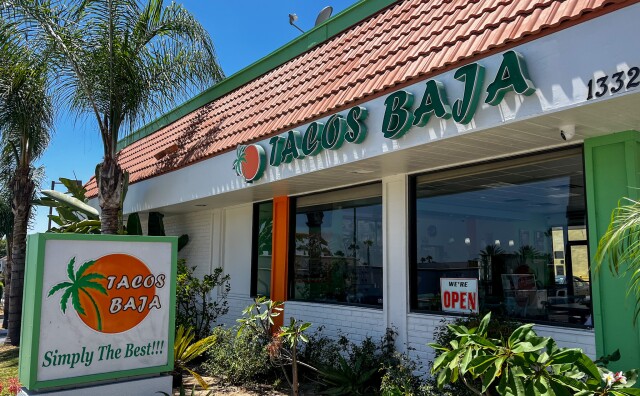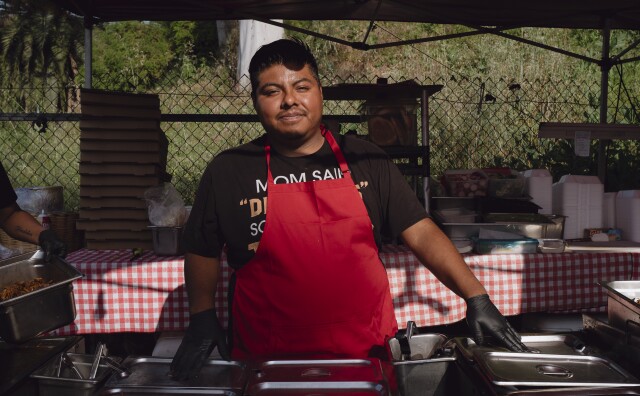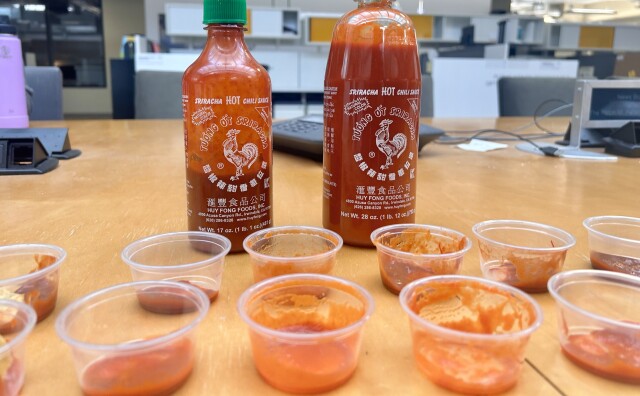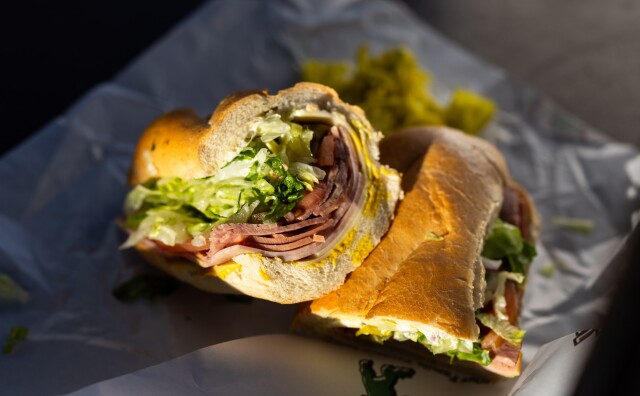From behind the counter, in front of enormous, sizzling piles of lengua (beef tongue), chicharron (pork skin) and buche (hog maw) on a bustling Monday afternoon around lunchtime, Tomas Martinez recalls the first time he visited Grand Central Market in his 20s, back in 1972.
“Things were very different then,” says Martinez, who opened his always-busy restaurant Tacos Tumbras a Tomas in 1995. “Before you had many Hispanic people, many Latin products and fish, meat, all kinds of things for Mexican and Latin people.”
For nearly 30 years, Martinez has come to Grand Central Market at 4 or 5 a.m., six days a week, to open his restaurant, serving burritos, tortas and his most popular dish: carnitas tacos. (His tacos are so good they made The LAist Guide To Eating Your Way Through Grand Central Market.)

Among the clacks of giant woks, the hiss of Korean short ribs and carne asada and the chatter of hungry visitors, Martinez gestures toward the 44,000 square foot open-air structure that resembles a sort of Grand Bazaar. “Now, it’s a mix,” he says. “But it is still our home. It’s a very important place in this city.”
For more than 100 years, the Grand Central Market has been a centerpiece of downtown Los Angeles for both locals and tourists. Drawing in around 2 million visitors annually, they can choose from nearly 40 of Los Angeles’ best local eateries or shop for produce, spices and other specialty goods.

Around the corner from Tacos Tumbras, Mike Kalustian sits on a red-leather bar stool at China Cafe, hunched over a steaming bowl of wonton soup — the same dish he’s been ordering here for more than 30 years, first as a downtown employee, now as a retiree who travels here from the valley at least a few times a month to enjoy his favorite meal.
“It’s the best $12 meal you can buy in the city,” he says. “It used to be $6 back in the day."
Over the years, Kalustian has also had a front-row seat to the market's transformation from a place for farmers to sell their produce to a more upscale food hall reflecting the wide variety of cuisines in the city.
“It was a little dingier back then,” he says, describing the run-down amenities, saw dust covering the floors and a much less “foodie” crowd than the hip, industrial feel the market has today. “But I loved it then, and I love it now. Things have got to evolve.”
Grand Central Market’s roots

The first, the oldest
While longtime patrons and vendors describe a trendier, more gentrified scene today than ever before, Grand Central Market has always been in a state of evolution.
When the market opened in 1917, the city's first food hall, it catered to a mostly wealthy class of Angelenos — specifically, those living up above Hill street in Victorian mansions Bunker Hill. They would ride the Angels Flight funicular — made famous most recently by its appearance in La La Land — down the hill directly to the market.
At that time, Grand Central Market was a true marketplace with more than 90 vendors: stalls of colorful produce and international spices, pastries, Jewish deli meats, as well as fishmongers and other specialty groceries.
Archival photos of this time — known as L.A.’s “golden age,” when Hollywood was just beginning to boom — show shoppers dressed in their finest suits, coats and hats and vendors sporting bowties behind glistening piles of produce and fine deli meats.
Evolving with the neighborhood
But as the demographic in downtown LA changed drastically post WWII — when wealthy Angelenos moved into the suburbs and the Victorians in Bunker Hill became working-class houses — so did Grand Central Market.

The intricate displays of sparkling produce and specialty goods were replaced by vendors selling everyday, inexpensive grocery items, catering to the mostly working class Latino customers who would go to market to eat and shop during their lunch breaks or after their shifts.
“It was really just a place for the working class to save money and come together,” Kalustian recalls. “It wasn’t so much a place to go and be seen. It was truly just a great place to get a cheap meal.”
Though the market has transformed yet again since then, vestiges of this era can be seen today: at Valeria’s Chiles & Spices you’ll find rare, specialty Latin goods like dried chiles, spices, beans, dried shrimp and canned Latin foods that are nearly impossible to find anywhere else, as well as fresh homemade moles; La Huerta Candy sells American candies with a Mexican twist — like watermelon gummies sprinkled with Tajin — as well as specialty Mexican nuts and dried fruits.
valer
Now, a microcosm of L.A.
Today, with vendors selling goods ranging from a $4 taco, a $12 bowl of wonton soup, to trendier cold pressed green juice, artisanal breads and craft beers, is a sort of microcosm of Los Angeles’ evolution throughout the century since its opening.
“There’s something for everyone’s taste,” Martinez says. “One person can get a sandwich, one person a taco, you can’t go wrong here at the market.”
But for long-time, loyal customers like Katusian, Grand Central Market is more than just a convenient destination to satisfy anyone’s culinary palate or explore new restaurants. It’s a uniquely L.A. tradition that breeds a true sense of community — one that’s hard to find in a city so spread out and car-centric, Katusian says.
Recently, he introduced his teenage children to the wonton soup at China Café.
“They loved it. They get to experience the same joy I have for so many years,” he says.
“It’s different," he added of the ever-changing market, "but it still has that same magic."










